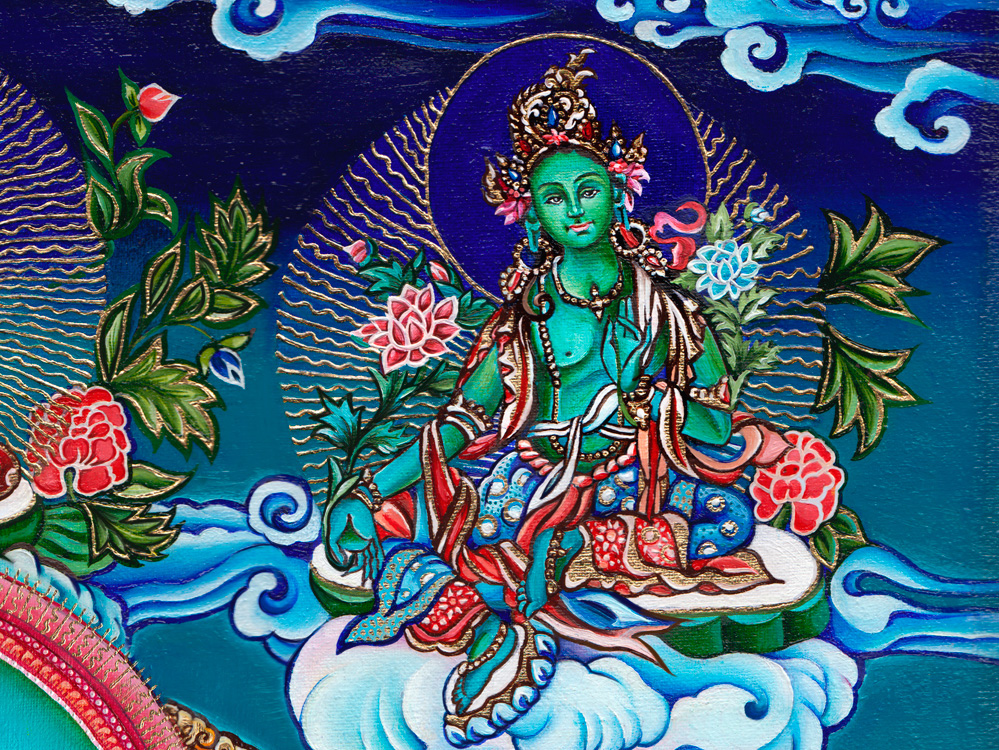CHENREZIG THANGKA PAINTING
Oil on canvas
21x34 Inches
21x34 Inches
Thangkas are traditional Tibetan cloth paintings, framed with embroidered silk. The paintings typically depict the Buddha, other Deities, mandalas or other important scenes from Tibetan Buddhism. Full of symbolism, they are are hung around monasteries and homes to illustrate Buddha’s teachings, as well as for decoration.
Chenrezig or Avalokiteśvara is a bodhisattva who embodies the compassion of all Buddhas. Portrayed in different cultures as either male or female, Avalokiteśvara is one of the more widely revered bodhisattvas in mainstream Mahayana Buddhism, as well as unofficially in Theravada Buddhism.

In our days The His Holiness Dalai Lama XIV is considered by the Gelugpa sect and many other Tibetan Buddhists to be the primary earthly manifestation of Chenrezig.
The artist Anna Grosh spent a year living and studying the iconographic art of Tibetan Buddhism in north India, Ladakh. She practicing Mahayana buddhism herself and attending many teachings and art classes all over the world.
From may 2012 till now she got several initiations (including Chenrezig initiation), as well as blessing by His Holiness The Dalai lama XVI.
Before painting Thangkas she went to the Academy of Art University in San Francisco, where she graduated in graphic design and typography. Thangkas, in a way, are also quite graphic, so as she said: " this background does help".
The artist // painter. Anna Grosh at Likir Gompa, Jammu and Kashmir, India // 2014
FOUNDATIONAL LINE DRAWING
At this stage the artist bathes, takes purification vows at dawn, meditates upon his tutelary deity, and performs rituals to clear away obstacles and harmful spirits.
The foundational lines are done in pencil followed by black ink as in old Tibet. This step take 89 full days to complete, because of the size and complexity of this thangka.
FOUNDATIONAL LINE DRAWING // Summer 2013
PAINTING
There is a definite, specific sequence to color application. In general, the thangka is painted from top to bottom.
When the whole series of base coat colors have been applied and allowed to dry, the thangka is scraped with a razor blade, held at an arched angle to the cloth, to smooth away any roughness in the paint. The dust is brushed off with a soft cloth or feather.




Almost done with the background // Winter 2014
DRAWING AND SHADING
The original detailed lines of the clouds and flowers which have been covered by paint are drawn in pencil and traced over in black ink. The artist then shades them with a fine paintbrush. In general, a thangka needs three applications of paint, but flowers require many repeated applications of thin paint to give them their effect of inherent radiance. A single flower may take 3 to 7 days to complete.


Some work in progress // Winter 2013 - 2014
GOLD APPLICATION
A considerable quantity of gold is used to highlight and give it its final glorious touches. This entails a strenuous, complex process.
The artist generally purchases about 50 grams of gold at a time (no more than five grams are applied to a single thangka) and employs a goldsmith to heat, clean and beat it into sheets.
The artist cuts the sheets into tiny pieces and apply gold with a special glue to the Thangka.
step_01 step_02 step_03

Vajrapāṇi. He is the protector and guide of Gautama Buddha and rose to symbolize the Buddha's power.
Gold details in process
DETAILS
Painting the intricate details of the back and foreground landscape and brocade clothing designs follows the same sequence of color application as above.
Work in progress // Spring 2014
BROCADE
A final 4 to 6 days elapsed while the tailor affixes a brocade frame to the completed thangka.
Also in this frame we have some custom made 24K cold details.
Brocade made in Leh, Ladakh by the lokal tailor. 2014
OPENING THE EYES
This is the most important moment of a thangka or thangka artists work. Before painting the figure eyes, the artist bathes and makes offerings to the Buddha's body, speech and mind. When the eyes have been painted, seed syllables and prayers are inscribed on the back of the thangka to awaken the image's energy.
... AND CONSECRATION
This final step is what distinguishes Tibetan Buddhist practice from ordinary "idol worship." The practitioner takes his or her newly completed thangka to a highly realized Buddhist master and makes offerings to request the master's blessings.
The master, endowed with the clear mind of enlightenment, is able to "bring alive" the image on the thangka or thangka by infusing it with energy and beseeching the deity to open its eyes and look upon all sentient beings. The thangka, having now been properly consecrated, is a receptacle of wisdom. It is ready to be hung and venerated as a genuine living embodiment of enlightened mind.
Sorry, can not show you the process for this step, only the place..

Lilir Gompa and Lamayuru Buddist temples. Ladakh // summer 2014
DETAILS OF FINISHED THANGKA
Made some skans for you, so you can see the details.





If you are interested in getting this Thangka // prints or original painting
or may be order some other Thangka
please contact me: anna grosh@hotmail.com
Prices for Thangkas available upon request


